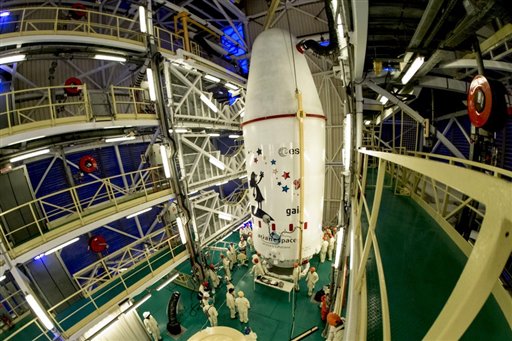(AP) Europe launches satellite to map 1 billion stars
By FRANK JORDANS and DANICA COTO
Associated Press
BERLIN
The European Space Agency successfully launched its star-surveying satellite Gaia into space Thursday in a bid to produce the most accurate three-dimensional map of the Milky Way, and provide an insight into the evolution of our galaxy.
The satellite was lifted into space from French Guiana at 6:12 a.m. (0912 GMT; 4:12 a.m. EST) aboard a Russian-made Soyuz rocket, the agency said. It is heading to a stable orbit on the opposite side of the Earth from the sun, known as Lagrange 2, where it will arrive in about a month’s time.
Timo Prusti, ESA’s project scientist, likened the mission’s goal to the switch from two-dimensional movies to 3D. At the moment, scientists are working with a largely “flat” map of the galaxy. “We want to have depth,” he said.
Once Gaia arrives at the Lagrange 2 point some 1.5 million kilometers (930 million miles) from Earth, the satellite will unfold a 10-meter (33-feet) circular sun shield. This will protect Gaia’s sensitive instruments from the rays of the sun, while simultaneously collecting solar energy to power the spacecraft.
Using its twin telescopes, Gaia will study the position, distance, movement, chemical composition and brightness of a billion stars in the galaxy, or roughly 1 percent of the Milky Way’s 100 billion stars.
The data will help scientists determine the Milky Way’s origin and evolution, according to Jos de Bruijne, deputy project scientist for the Gaia program.
The project is the successor to ESA’s Hipparcos satellite, which was launched in 1989 and measured the position of 100,000 stars in the Milky Way.
Gaia, which is named after an ancient Greek deity, will go far beyond that. Scientists have compared its measuring accuracy to measuring the diameter of a human hair from 1,000 kilometers (600 miles) away.
ESA has dubbed Gaia the “ultimate discovery machine” because its sophisticated instruments will allow scientists to look for small wobbles in stars’ movements that indicate the presence of nearby planets.
Equipped with dozens of cameras capable of piecing together 1,000-megapixel images, scientists also expect to find hundreds of thousands of previously undiscovered asteroids and comets inside our solar system.
Beyond that, scientists hope that Gaia can also be used to test a key part of Albert Einstein’s General Theory of Relativity that predicts “dips” and “warps” in space caused by the gravity of stars and planets.
Carmen Jordi, an astronomer at the University of Barcelona who is involved in the mission, said the satellite’s findings would become the main reference for scientists in the years to come.
Science operations will begin in about 4 1/2 months. The 740 million-euro ($1-billion) mission, which was delayed by about a month due to a technical problem with another satellite, has a planned lifetime of five years.
If Gaia is still operational after that, scientists say they might extend its mission for up to two years.
___
http://www.esa.int/gaia
___
Coto contributed from San Juan, Puerto Rico.

COMMENTS
Please let us know if you're having issues with commenting.